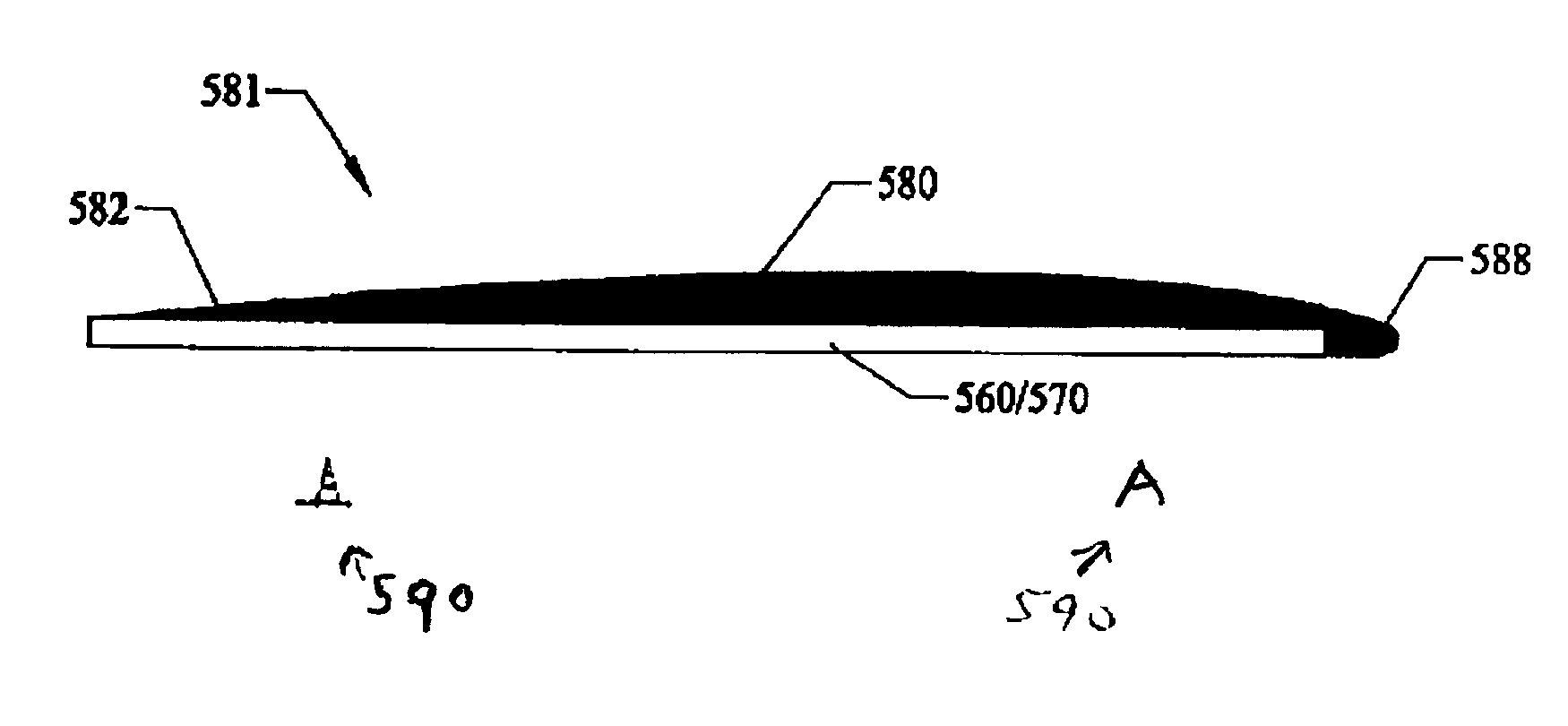Efficient traditionally appearing ceiling fan blades with aerodynamical upper surfaces
a technology of aerodynamic upper surfaces and ceiling fans, which is applied in the direction of marine propulsion, liquid fuel engines, and vessel construction, etc., can solve the problems of excessive noise, flat ceiling fan blades have problems, and the air moving performance is relatively poor at different operating speeds, so as to reduce the low operational speed and reduce the low operational forward speed
- Summary
- Abstract
- Description
- Claims
- Application Information
AI Technical Summary
Benefits of technology
Problems solved by technology
Method used
Image
Examples
first embodiment
Small Diameter Blades
[0136]The labeled components will now be described.[0137]1 novel small diameter blade[0138]5 dotted lines for motor mount arm connection[0139]10 tip end[0140]20 root end[0141]30LE leading edge[0142]40TE trailing edge[0143]50 upper surface[0144]60 lower surface
[0145]FIG. 1A is a top perspective view of a first embodiment efficient traditionally appearing ceiling fan blade 1 with aerodynamical upper surfaces 50 and wide tip end 10. FIG. 1B is a bottom perspective view of the blade 1 of FIG. 1A with planar / flat appearing lower surface 60. FIG. 1C is a top planar view of the blade 1 of FIG. 1A showing upper surface 50. FIG. 1D is a bottom planar view of the blade 1 of FIG. 1A. FIG. 1E is a left side view of the blade 1 of FIG. 1A along arrow 1E with leading edge 30LE. FIG. 1F is a right side view of the blade 1 of FIG. 1A along arrow 1F with trailing edge 40TE FIG. 1G is a tip end 10 view of the blade 1 of FIG. 1A along arrow 1G. FIG. 1H is a root end 20 view of the...
second embodiment
Large Diameter Blades
[0159]The labeled components will now be described.[0160]101 novel large diameter blade[0161]105 dotted lines for motor mount arm connection[0162]110 tip end[0163]120 root end[0164]130LE leading edge[0165]140TE trailing edge[0166]150 upper surface[0167]160 lower surface
[0168]FIG. 5 is a top perspective view of a second embodiment of a large efficient traditionally appearing ceiling fan blade 101 with aerodynamical upper surfaces 150 and wide tip end 110 with labeled cross-sections A, B, C, D, E, F, G, H. FIG. 6 is a top view of the large efficient traditionally appearing ceiling fan blade 101 with aerodynamical upper surfaces 150 of FIG. 5 with labeled cross-sections A-H.
[0169]Referring to FIGS. 5-6, blade 101 has an overall length of approximately 21.08″ and a width that varies from the root end 120 being approximately 4.85″ to the tip end 110 being approximately 5.95″. Cross-section A is taken at the tip end 110 with cross-section B approximately 1″ in and cro...
third embodiment
Rounded Wide Tip End Blades
[0180]The labeled components will now be described.[0181]301 novel efficient aerodynamic blade with rounded tip end[0182]305 dotted lines for motor mount arm connection[0183]310 tip end[0184]320 root end[0185]330LE leading edge[0186]340TE trailing edge[0187]350 upper surface[0188]360 lower surface
[0189]FIG. 9A is a top perspective view of a third embodiment efficient traditionally appearing ceiling fan blade 301 with aerodynamical upper surfaces 350 and rounded wide tip end 310. FIG. 9B is a bottom perspective view of the blade 301 of FIG. 9A. FIG. 9C is a top planar view of the blade 301 of FIG. 9A. FIG. 9D is a bottom planar view of the blade 301 of FIG. 9A. FIG. 9E is a left side view of the blade 301 of FIG. 9A along arrow 9E. FIG. 9F is a right side view of the blade of FIG. 9A along arrow 9F. FIG. 9G is a tip end 310 view of the blade 301 of FIG. 9A along arrow 9G. FIG. 9H is a root end 320 view of the blade 301 of FIG. 9A along arrow 9H. Referring t...
PUM
 Login to View More
Login to View More Abstract
Description
Claims
Application Information
 Login to View More
Login to View More - R&D
- Intellectual Property
- Life Sciences
- Materials
- Tech Scout
- Unparalleled Data Quality
- Higher Quality Content
- 60% Fewer Hallucinations
Browse by: Latest US Patents, China's latest patents, Technical Efficacy Thesaurus, Application Domain, Technology Topic, Popular Technical Reports.
© 2025 PatSnap. All rights reserved.Legal|Privacy policy|Modern Slavery Act Transparency Statement|Sitemap|About US| Contact US: help@patsnap.com



